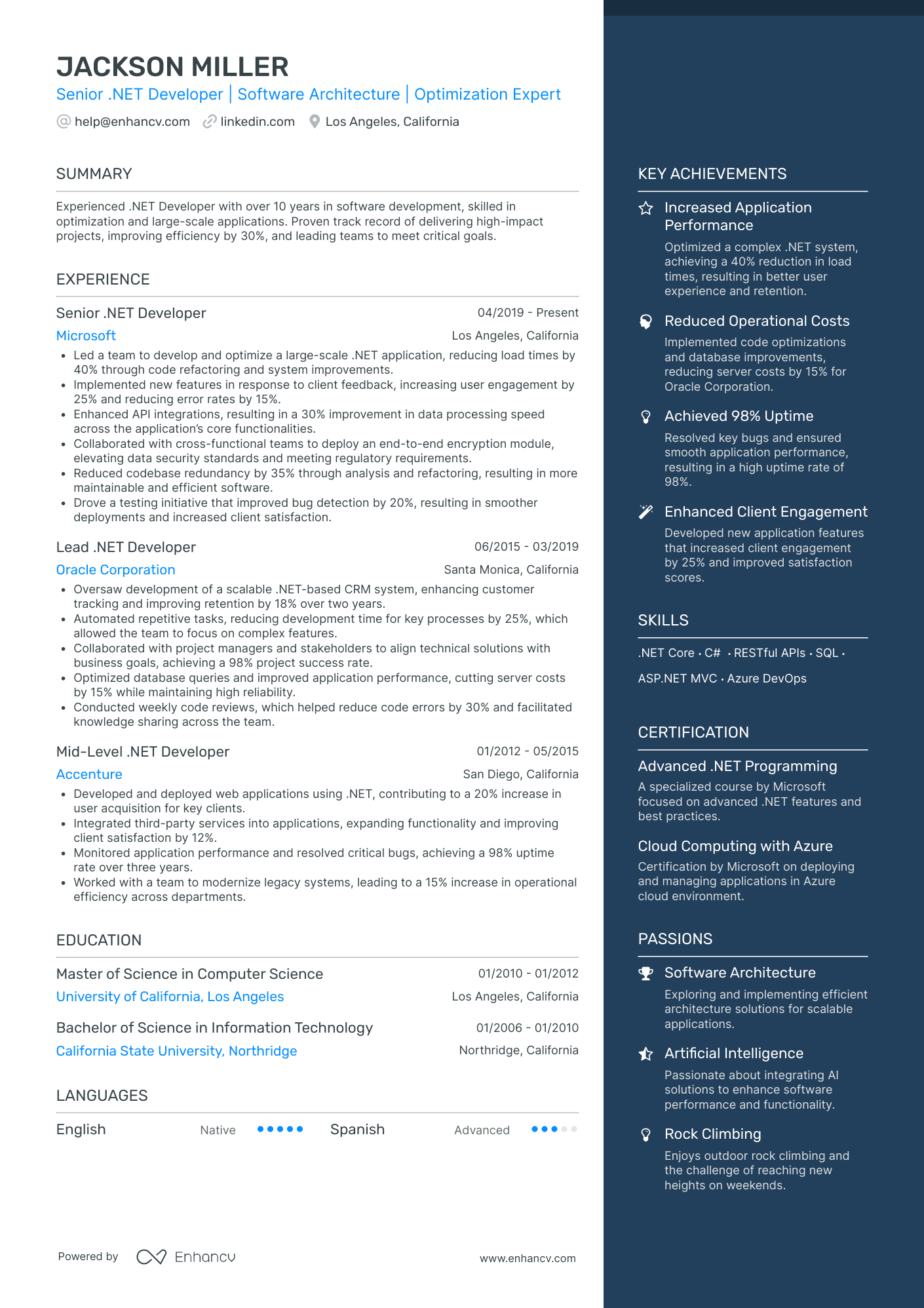With 10 years of experience, your resume should do more than just list job titles. It should illustrate growth, impact, and specialized skills. At this stage, you’re positioning yourself as a seasoned professional, so your resume needs to focus on achievements and a proven track record.
This guide will walk you through crafting a resume that underlines your value and sparks interest in your experience.
Here’s a short preview of the article’s main insights before we explore further.
Key takeaways
- Start with a concise summary that presents top achievements, key skills, and the overall value you bring.
- Impress with your expertise right from the headline by highlighting quantifiable results (e.g., “10+ years of increasing sales by 20% annually”).
- Limit the resume to one to two pages. Prioritize recent, relevant experiences and avoid going too in-depth on roles from over a decade ago.
- Highlight specific accomplishments for each role rather than just listing duties.
- Make promotions or increased responsibilities clear to show growth and adaptability.
With 10 years under your belt, you might be wondering how long your resume should actually be. Let's break it down.
How long should your 10-year experience resume be?
The ideal resume length for 10 years of experience depends on your specific background. A single page often works best, especially for HR, as long as you focus on relevant experience, key achievements, and essential skills. With a professional resume template, you can capture everything important on one page.
However, if you have an extensive portfolio of publications, projects, or certifications, expanding to two pages can be more effective in showcasing your full expertise.
Make your 10+ years of experience count. Use our AI builder to create a standout resume, or improve your current one with Enhancv’s free checker.
Is your resume good enough?
Drop your resume here or choose a file. PDF & DOCX only. Max 2MB file size.
You might be wondering how to write a resume with 10 years of experience. Take a look at the .NET developer resume sample below to see how it’s done.
Experience allows us to repeat our successes and avoid past mistakes.
Richard Branson, English business magnate
Best resume format for 10 years of experience
For professionals with 10+ years of experience, the reverse-chronological and combination resume formats are typically the best choices.
Here's how each format can work best and when to choose one over the other.
Reverse chronological resume format
This format focuses on your work experience, starting with your most recent role and going backward. It’s ideal if you have a strong, consistent career progression and want to underscore your long-standing expertise in a particular field.
The reverse chronological resume emphasizes stability and growth over time, which appeals to employers looking for proven expertise and reliability.
You can structure your application as follows:
- Start with a strong professional summary.
- List jobs in reverse chronological order, with recent roles given the most space.
- Include measurable achievements and results to prove your impact in each role.
Combination resume format
It blends a skills-focused approach with a chronological work history. This hybrid format works well for seasoned professionals who want to highlight both their skills and the depth of their experience.
It allows you to feature critical skills and accomplishments upfront while still detailing your career progression, making it ideal for experienced professionals with specialized expertise.
You can organize your document like this:
- Start with a summary and skills section to outline key abilities and strengths.
- Follow with your work experience in reverse chronological order, giving context to the skills and accomplishments listed above.
Now, let’s look at a sample resume tailored for a SAP ABAP Developer with 10+ years of experience.
Resume sample resume for a professional with 10 years of experience
If you're struggling to capture your experience effectively, this sample resume can point you in the right direction.
Alexandra Evans
SAP ABAP Developer
(415) 555-9876 | a.evans@gmail.com | @LinkedIn | San Francisco, CA
Summary
Experienced SAP ABAP Developer with 12 years of expertise in creating and optimizing SAP solutions for enhanced business efficiency. Skilled in SAP ECC and S/4HANA, Agile methodologies, and debugging to deliver high-quality, customized solutions that align with client objectives. Proven ability to manage complex SAP projects, reduce operational costs, and improve system performance.
Experience
Senior SAP ABAP Developer
BlueTech Solutions, San Francisco, CA
March 2018 – Present
- Design and optimize SAP ABAP programs, resulting in a 35% increase in system efficiency for key clients.
- Collaborate with cross-functional teams to enhance SAP workflows in ECC and S/4HANA, reducing processing time by 20%.
- Develop custom ABAP solutions tailored to client needs, achieving a 97% satisfaction rate and driving project success.
- Utilize Agile methodologies to streamline development processes, boosting productivity by 25% across project phases.
- Conduct code reviews and debugging sessions, reducing error rates by 15% and improving program reliability.
SAP ABAP Developer
Innovate Solutions, Oakland, CA
April 2014 – February 2018
- Developed custom SAP reports and modules, enhancing data accuracy and operational efficiency by 30%.
- Integrated SAP ABAP applications with third-party systems, improving functionality and user experience.
- Implemented performance optimizations, leading to a 20% reduction in database query times.
- Worked closely with stakeholders to ensure that ABAP developments aligned with business objectives, increasing satisfaction.
Junior SAP ABAP Developer
FutureTek, San Jose, CA
January 2012 – March 2014
- Developed and maintained SAP ABAP programs across various modules, increasing processing speed by 15%.
- Assisted in the development of customized SAP reports, enhancing decision-making accuracy for end users.
- Performed troubleshooting and debugging, reducing system errors by 20% and enhancing application stability.
Education
Bachelor of Science in Information Systems
San Francisco State University, San Francisco, CA
May 2011
Certifications
- SAP Certified Development Associate – ABAP with SAP NetWeaver (2019)
- SAP Certified Application Associate – SAP S/4HANA (2020)
Skills
- SAP ABAP Development
- SAP ECC & S/4HANA
- Agile Methodologies
- Database Optimization
- Integration with Third-Party Systems
- Debugging and Troubleshooting
Languages
- English (Native)
- French (Working proficiency)
We showed you how to demonstrate 10 years of experience across different companies, but your career path might look different if you've spent that time at one working place.
Below, you’ll find a sample that illustrates how to display long-term experience within a single organization, highlighting growth, achievements, and project impact over the years.
Example of 10 years’ work experience in the same company
IBM Corporation, San Francisco, CA
SAP ABAP Developer
Years Worked: 2013–Present
Position progression:
Senior SAP ABAP Developer (2020–Present)
- Optimize complex ABAP programs, increasing system efficiency by 35%.
- Lead code reviews, reducing error rates by 20% and boosting team productivity.
- Collaborate on SAP S/4HANA implementation, cutting processing times by 25%.
- Develop custom modules tailored to client needs, achieving a 98% satisfaction rate.
SAP ABAP Developer (2016–2020)
- Managed ABAP projects, reducing processing times by 30%.
- Integrated third-party applications, enhancing user satisfaction by 20%.
- Reduced downtime by 15% through debugging and optimization.
Junior SAP ABAP Developer (2013–2016)
- Assisted in ABAP development, increasing data processing speeds by 10%.
- Supported senior developers in SAP report customization, improving insights.
- Resolved bugs, enhancing reliability and reducing error rates by 15%.
Consider including an achievements section to strengthen your resume. Here’s an example:
Writing a resume that features 10 years of experience requires focus and clarity to make the most impact
Tips to write the best 10 years experience resume
Here are some essential tips to help you craft the best possible resume for your background:
- Customize each resume for the specific role, emphasizing the skills and achievements that match the job description.
- Start each bullet point with strong action verbs like “led,” “optimized,” “implemented,” or “launched” to add impact.
- Certifications, courses, or continuing education can demonstrate your commitment to professional growth and expertise.
- Double-check for typos, dates, job titles, and bullet point consistency. Small errors can detract from a seasoned professional’s resume.
In conclusion
A resume with 10 years of experience should bring your skills, career milestones, and top achievements to life. Pick a format that lets your impact shine, use numbers that tell your story, and keep it crisp to show off your expertise and flexibility.
Make one that's truly you.




